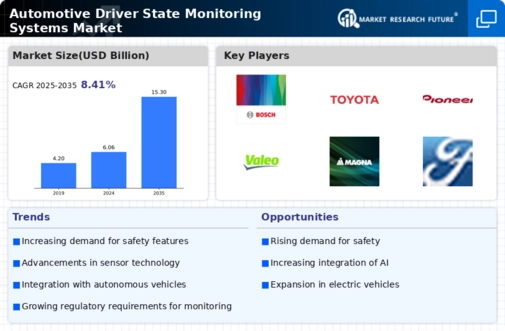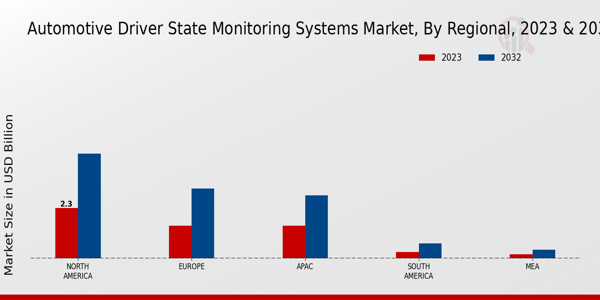Growing Emphasis on Road Safety Regulations
The Automotive Driver State Monitoring Systems Market is significantly influenced by the growing emphasis on road safety regulations. Governments and regulatory bodies are increasingly mandating the implementation of driver monitoring systems in new vehicles to mitigate accidents caused by human error. For instance, certain regions have introduced legislation requiring the installation of drowsiness detection systems in commercial vehicles. This regulatory push is likely to drive the adoption of driver state monitoring technologies, as manufacturers seek to comply with safety standards. The market is expected to witness a compound annual growth rate (CAGR) of approximately 15% over the next five years, driven by these regulatory requirements.
Rising Consumer Awareness of Vehicle Safety
The Automotive Driver State Monitoring Systems Market is also benefiting from rising consumer awareness regarding vehicle safety. As consumers become more informed about the risks associated with distracted and fatigued driving, there is a growing demand for vehicles equipped with advanced safety features, including driver state monitoring systems. Surveys indicate that a significant percentage of consumers prioritize safety technologies when purchasing vehicles, which is prompting automakers to integrate these systems into their offerings. This trend is expected to contribute to a robust market growth, with projections suggesting that the driver state monitoring segment could account for over 20% of the overall automotive safety market by 2027.
Technological Advancements in Sensor Technologies
The Automotive Driver State Monitoring Systems Market is experiencing a surge in technological advancements, particularly in sensor technologies. Enhanced sensors, including infrared and electroencephalogram (EEG) devices, are being integrated into vehicles to monitor driver alertness and cognitive states. These innovations are expected to improve the accuracy of driver monitoring systems, thereby reducing the likelihood of accidents caused by drowsiness or distraction. According to recent estimates, the market for advanced driver assistance systems, which includes driver state monitoring, is projected to reach USD 30 billion by 2026. This growth is indicative of the increasing reliance on sophisticated technologies to enhance vehicle safety and driver performance.
Increased Investment in Automotive Safety Technologies
The Automotive Driver State Monitoring Systems Market is witnessing increased investment in automotive safety technologies. Automakers and technology companies are allocating substantial resources to develop innovative driver monitoring solutions that leverage artificial intelligence and machine learning. This influx of investment is fostering a competitive landscape, encouraging the development of more sophisticated and reliable monitoring systems. Reports indicate that the automotive safety market is projected to grow at a CAGR of 12% through 2028, with driver state monitoring systems playing a crucial role in this expansion. As investments continue to rise, the market is likely to see enhanced product offerings that cater to the evolving needs of consumers and regulatory bodies.
Integration of Advanced Driver Assistance Systems (ADAS)
The Automotive Driver State Monitoring Systems Market is closely linked to the integration of Advanced Driver Assistance Systems (ADAS). As vehicles become increasingly automated, the need for effective driver monitoring systems becomes paramount to ensure that drivers remain engaged and alert. ADAS technologies, such as lane-keeping assist and adaptive cruise control, require continuous monitoring of driver behavior to function optimally. The market for ADAS is anticipated to grow significantly, with estimates suggesting it could reach USD 60 billion by 2025. This growth is likely to drive the demand for driver state monitoring systems, as manufacturers seek to enhance the overall safety and functionality of their vehicles.


















Leave a Comment